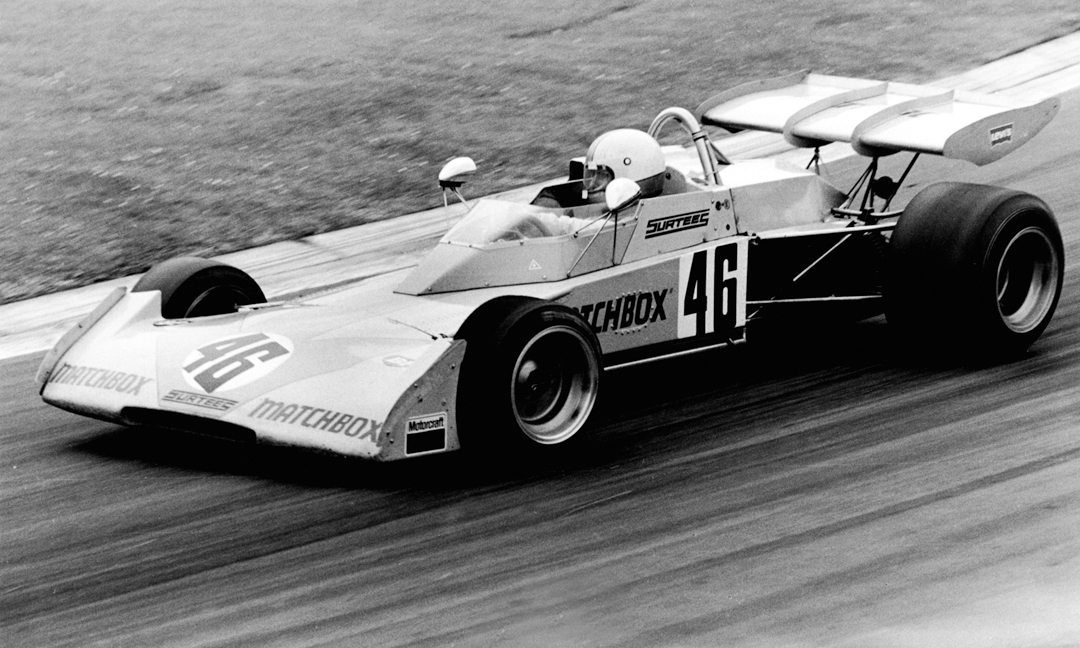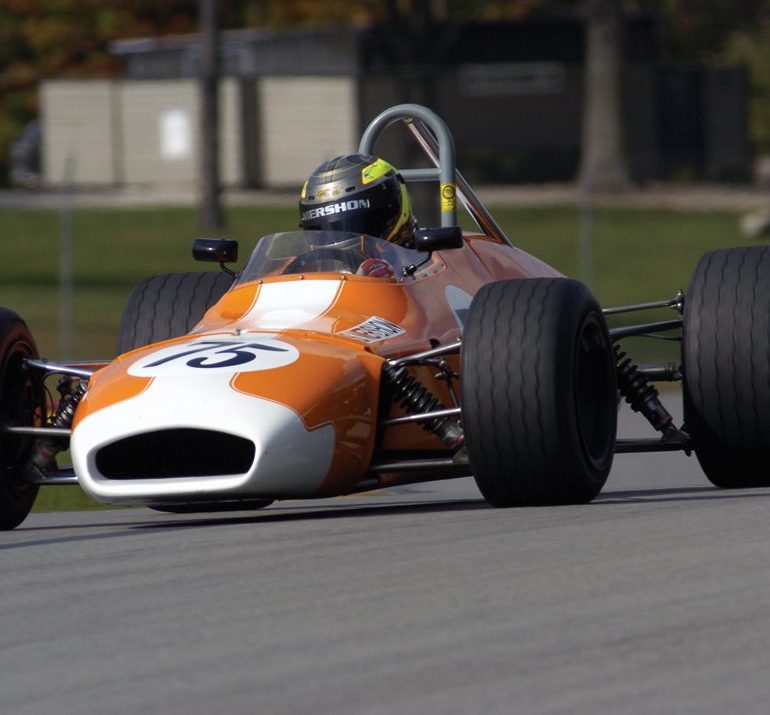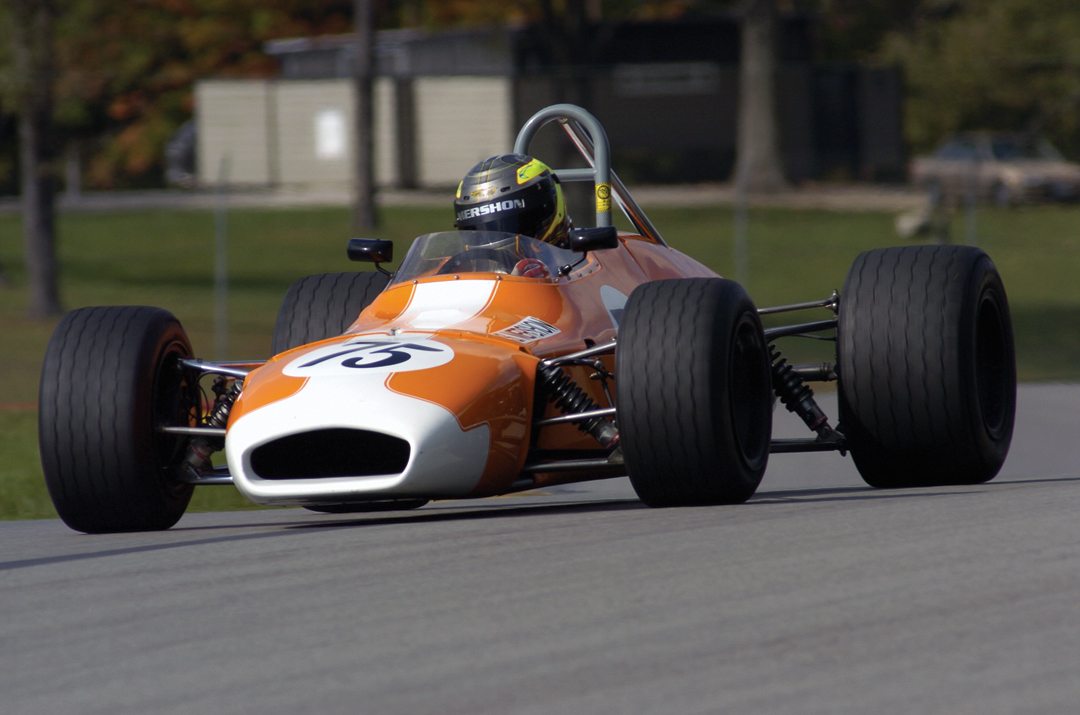From 1964 to 1978, a series of flat-bottomed, formula cars were manufactured to serve as a stepping stone to Formula One and the upper echelons of open-wheeled racing. In the late ’50s, F2 and F3 were consolidated into Formula Junior. However, with that category’s demise at the end of 1963, F2 was reformed, utilizing highly developed 1,000-cc, fuel-injected engines until 1966. From 1967 to 1971, racecars manufactured for F2 were equipped with a more powerful gear-driven Cosworth FVA engine, while in the United States many of the same chassis were being outfitted with Lotus twin-cam engines for what was known as FB. By 1972, F2 graduated to 2-liter displacement, with engines being manufactured by firms such as Cosworth, Hart and BMW. During this same period, Formula Atlantic replaced FB, both in the United States and overseas, with similar chassis to the F2 cars, but running the 1,600-cc Cosworth BDA or BDD engine.
Though various models were sold in both F2 and Atlantic form, the F2 cars today command a much higher value due to their more sophisticated and expensive engines. The value of these F2 variants is also bolstered by the fact that they were usually driven by some of the greatest, current or up-and-coming F1 drivers of the day, names such as Jackie Stewart, Jochen Rindt, Niki Lauda, Emerson Fittipaldi and the like.
| Make | Model | Level III | Level II | Level I |
| Brabham | BT10 | $35,000 | $40,000 | $50,000 |
| BT16 | $35,000 | $40,000 | $50,000 | |
| BT18 | $40,000 | $50,000 | $60,000 | |
| BT21 | $40,000 | $50,000 | $65,000 | |
| BT23C F2 | $85,000 | $100,000 | $115,000 | |
| BT29 FB | $60,000 | $70,000 | $85,000 | |
| BT30 F2 | $90,000 | $110,000 | $125,000 | |
| BT35 FB/FA | $45,000 | $55,000 | $65,000 | |
| BT36 F2 | $90,000 | $110,000 | $125,000 | |
| BT38/BT40 F2 | $65,000 | $75,000 | $85,000 | |
| Chevron | B15B | $55,000 | $65,000 | $75,000 |
| B17B | $60,000 | $70,000 | $80,000 | |
| B18 | $55,000 | $65,000 | $75,000 | |
| B20 | $60,000 | $70,000 | $80,000 | |
| B27/B29 FA | $45,000 | $50,000 | $55,000 | |
| B34 FA | $45,000 | $55,000 | $65,000 | |
| B35 F2 | $60,000 | $70,000 | $80,000 | |
| B40 F2/B42 F2 | $65,000 | $75,000 | $85,000 | |
| Lola | T60/61/62 | $45,000 | $50,000 | $60,000 |
| T100/102 | $45,000 | $55,000 | $60,000 | |
| T360 FA | $45,000 | $50,000 | $55,000 | |
| T460 FA | $35,000 | $40,000 | $45,000 | |
| Lotus | 32 | $50,000 | $55,000 | $60,000 |
| 41B | $50,000 | $55,000 | $60,000 | |
| 48 F2 | $90,000 | $100,000 | $110,000 | |
| 59B | $55,000 | $65,000 | $75,000 | |
| 69 FB | $65,000 | $75,000 | $85,000 | |
| 69 F2 | $90,000 | $110,000 | $125,000 | |
| March | 712 F2 | $85,000 | $100,000 | $110,000 |
| 722 F2 | $60,000 | $70,000 | $75,000 | |
| 762 F2 | $55,000 | $65,000 | $75,000 | |
| 772/782 F2 | $65,000 | $75,000 | $85,000 | |
| 75B/76B | $45,000 | $55,000 | $65,000 | |
| 77B/78B | $55,000 | $60,000 | $65,000 | |
| Martini | MK19/22 F2 | $65,000 | $75,000 | $85,000 |
| McLaren | M4 FB | $65,000 | $75,000 | $85,000 |
| M4 F2 | $90,000 | $100,000 | $115,000 | |
| Merlyn | Mk7/9 | $40,000 | $45,000 | $50,000 |
| Ralt | RT1 Atlantic | $50,000 | $60,000 | $70,000 |
| Surtees | TS10 | $65,000 | $70,000 | $80,000 |
| TS15 | $55,000 | $65,000 | $75,000 |
1972 Surtees TS10 F2

John Surtees, the motorcycle and Formula One World Champion, ventured into racecar construction in 1969. The first Formula 2 car he built was the TS10 and it was an immediate success, partly because of a good design, sturdy construction, and the brilliance of the driving by motorcycle World Champion, Mike Hailwood. This was also the first year of the 2.0-liter formula and Surtees chose the more reliable 1,850-cc Hart-developed BDA engine. This combination, in a very competitive field, brought excellent results. Resplendent in Matchbox Livery, with shovel nose, the TS10 was an excellent F2 car then and is still now. Formula 2 cars of this era are exciting to drive and give the most performance for the money.
1969 Brabham BT29 Formula B
Jack Brabham’s company, with designer Ron Tauranac, built successful single-seaters for many categories. Brabham’s car for the U.S. SCCA Formula B category was the BT29. It was a space-frame design, with outboard suspension, powered by a 1,600-cc Lotus Twin-Cam engine and a sturdy 5-speed, Hewland FT200 gearbox. This car was an excellent handling, predictable, sturdy car that Brabham clients had come to expect. It had enormous success in U.S. SCCA competition, winning multiple titles. The BT29 shared a similar frame design with the BT28 1000-cc Formula 3 car and the BT30 1600-cc Formula 2 car. To identify them, the BT29 had a chassis plate mounted on the dashboard with, for example, the number BT29-7 (chassis number 7); in the sequence of numbers, 13 was left out. The frames were built by Arch Motors, to Brabham’s specifications. They had a frame number stamped on the rear of the frame, on the gusset, adjacent to the upper damper attachment hole on the rear cross member: AM 69 21. This indicates that Arch Motors made the frame in 1969. This cannot cross-reference to the dashboard plate. These cars are very popular today in historic racing across the United States.
Criteria Used For Assessing Valuations for this Guide:
- Degree of Originality
- Overall Condition, Restoration
- Technology, Design, Coachbuilder
- Production Numbers/Rarity
- Competition History
- Ownership History, Documentation
- Modern Event Eligibility
Regional Variances
The prices stated in this guide are based on U.S. values. The values of historic racing cars can vary as much as 25%-35% in other countries, depending on local market appeal, currency rates, import duties, and VAT. Most of the time, we are able to document known sales or closed escrows, as they say in real estate. When this is not possible, a logical estimate of the car’s value is given, based on its sales history and relationship to cars of its type.
The prices stated in this guide are based on U.S. values. The values of historic racing cars can vary as much as 25%-35% in other countries, depending on local market appeal, currency rates, import duties, and VAT.
LEVEL |
VALUATION CATEGORIES |
|---|---|
I |
The best combination of all criteria. |
II |
Satisfies mid-range of criteria. |
III |
In need of restoration. Meets only a few points of criteria |





